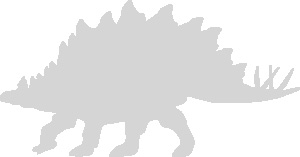Every month, 100,000 readers use the Dinosaur Database, but we receive no support from you. Developing and updating the database requires a lot of work. If you want it to remain open and be updated, please support us via the "Buy us a coffee" button available on every page or via the Support page.
Dinosaur: Baiyinosaurus baojiensis

| Length*: | 4.8 m | 15.7 ft |
| Weight*: | 850 kg | 1,874 lb |
*The largest known specimen
Period
Epoch: Middle Jurassic
Stage: Late Bathonian
Years: 168-166 Ma
Details
Status: valid
Author: Ning et al.
Year: 2024
Distribution
Area: Asia
Country: China
Region: Gansu
Formation: Wangjiashan
Description
Baiyinosaurus baojiensis
Baiyinosaurus baojiensis is a recently described stegosaurian dinosaur from the Middle Jurassic (Bathonian stage, approximately 168-164 million years ago) of Gansu Province, China. This new species belongs to the clade Stegosauria, which includes the famous Stegosaurus. The discovery of Baiyinosaurus sheds light on the early evolutionary history of stegosaurs and their spread across the ancient supercontinent. The genus name Baiyinosaurus refers to the Baiyin Basin in China, where the fossils were found, while the species name baojiensis honors the nearby city of Baoji.
Physical Characteristics
The remains of Baiyinosaurus baojiensis consist of skull fragments, vertebrae, and a lower jaw, providing valuable insights into the anatomy of early stegosaurs. The skull bones include broad frontals, which are shorter than those of many later stegosaurs. These bones form part of the supratemporal fenestrae, indicating a unique feature in its cranial structure. The dentary (lower jaw) preserves 18 tooth sockets with some partially erupted teeth. These teeth have denticles (tooth serrations) on both the front and back edges, indicating a herbivorous diet.
The postcranial skeleton includes vertebrae from various regions of the spine. Notably, the neural arches are not significantly elongated, similar to more primitive stegosaurs such as Huayangosaurus and Gigantspinosaurus. Additionally, Baiyinosaurus lacks the prominent osteoderms (bony plates) seen in more derived stegosaurs like Stegosaurus.
Diet and Feeding Habits
Like other stegosaurs, Baiyinosaurus was a herbivore. Its dentary structure, including peg-like teeth with serrations, suggests it fed on tough plant material, possibly including ferns, cycads, and other low-lying vegetation common in the Jurassic period. The lack of chewing adaptations indicates that it likely swallowed food whole, relying on a fermentation-based digestive system to break down plant matter.
Habitat and Distribution
Baiyinosaurus lived in what is now north-central China, in a humid, forested environment with rich plant life. The Gansu region during the Jurassic was part of a diverse ecosystem, home to a variety of herbivorous and carnivorous dinosaurs, as well as other vertebrates. The presence of Baiyinosaurus in Asia provides evidence of early stegosaur radiation across Laurasia.
Discovery and Research
The fossils of Baiyinosaurus baojiensis were unearthed in 2016 by Li Daqing and formally described in 2024 by a team led by Ning Li. The discovery adds a significant new species to the basal members of Stegosauria, highlighting the evolutionary diversity of stegosaurs during the Middle Jurassic period. Research on this species continues, with hopes of uncovering more complete remains to better understand its physiology and behavior.
Significance and Interesting Facts
Baiyinosaurus is significant for its basal position in stegosaur evolution. Its discovery helps fill gaps in the fossil record, particularly regarding the early diversification of stegosaurs in Asia. Its anatomy shows similarities with both basal thyreophorans (like Scelidosaurus) and more derived stegosaurs, illustrating a transitional form.
One notable fact is that Baiyinosaurus lacks the prominent plates characteristic of later stegosaurs, offering insight into the gradual development of these iconic features.
Locations
Sources
Material: Partial cranium, cervical vertebra, 7 dorsal vertebrae and one caudal vertebra.
References: Ning, Li; Maidment, Susannah C. R.; Daqing, Li; Hailu, You; Guangzhao, Peng (2024). "A new stegosaur (Dinosauria: Ornithischia) from the Middle Jurassic of Gansu Province, China".



